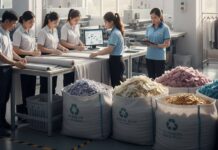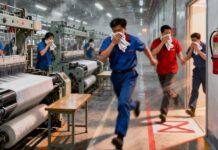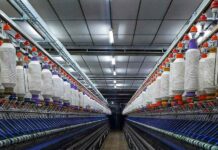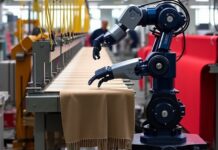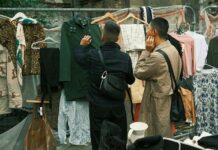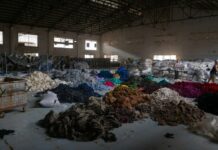President Donald Trump’s trade war aimed at reshoring apparel manufacturing faces a significant challenge due to immigration raids that threaten to decimate the domestic workforce in the sector.
During recent earnings calls, executives from various department stores and apparel retailers have reported that new tariff policies are forcing them to scramble for goods while attempting to keep import duties as low as possible. This has led to negotiations with factories to share the financial burden and a noticeable reduction in sourcing from China. However, few—if any—are making efforts to increase their acquisition of clothing made in the United States.
The reality is stark: textile manufacturing has largely relocated overseas, a trend ostensibly driving this year’s series of tariffs. The remnants of the industry in the U.S., which has historically relied on immigrant labor since its inception in 19th-century New York City, are now concentrated in Los Angeles.
According to the Garment Worker Center, textile factories in Los Angeles serve as the city’s largest manufacturing sector, employing over 45,000 workers, primarily from Latin America and Asia. While the immigration status of these workers is hard to determine, a recent survey conducted by the Garment Worker Center revealed that more than 60% of respondents are undocumented, with only 14% holding documented status; the remainder either refused to disclose their status or were in the process of obtaining legal papers.
Consequently, it is unsurprising that garment workers became targets during U.S. Immigration and Customs Enforcement (ICE) raids, which have sparked protests throughout Los Angeles. Reports indicate that at least 20 workers were detained at two apparel companies, with the Garment Worker Center releasing a statement in early June concerning the incidents. One of the involved companies, Ambiance Apparel, did not respond immediately to requests for comment, while ICE acknowledged receiving inquiries about its focus on the apparel sector but has yet to provide a response.
Immigrants have been integral to the apparel manufacturing industry, as tasks such as cutting, sewing, and finishing still require considerable manual labor despite advances in technology. Patrick Penfield, a professor of supply chain management at Syracuse University’s Whitman School of Management, explained, “The pay is very low, it’s difficult, but they don’t have to know the language so it typically lends itself to immigrants coming into work. But with what’s going on with ICE and deporting people, it’s going to cause some major issues, not only for apparel manufacturing, but also for food. We’re going to struggle to try and fill those positions and get companies to actually make apparel here in the States.”
On social media, Trump appeared to acknowledge the challenges faced by sectors like food production and hospitality, suggesting potential policy adjustments for these industries: “Our great Farmers and people in the Hotel and Leisure business have been stating that our very aggressive policy on immigration is taking very good, long-time workers away from them, with those jobs being almost impossible to replace.”
While there is currently a pause on raids targeting farms and hospitality businesses, it remains unclear how this policy shift affects garment factories, according to recent reporting from the New York Times. Neither ICE nor the White House has responded to inquiries regarding potential policy changes and their applicability to the U.S. apparel industry.
Despite some reforms, the low wages and often harsh working conditions in U.S. garment manufacturing have seen little improvement over the years. Many immigrants continue to endure these conditions in hopes of providing better opportunities for their families. Rosa DeLauro, an 82-year-old Democrat from Connecticut and the ranking member of the House Appropriations Committee, shared last month at a hearing how her mother would bring her to work to instill the importance of education.
“She worked in the old sweatshops in the city of New Haven … and the conditions there were horrific — dangerously hot, unsanitary,” DeLauro recounted. “Mostly immigrant women bent over sewing machines, trying to pump out the dresses as fast as they could, because they’re on piece work. You know anything about the needle trades? You get your finger caught in those high-powered machines, you just pull back, you wrap your hand up, because if you get a drop of blood on the garment, you don’t get paid for it.”
Earlier this year, the Garment Worker Center issued a statement advocating for “smart tariffs tied to labor rights violations, paired with real protections for workers here and abroad,” cautioning that “tariffs alone will not support domestic industries, and, as proposed, they threaten to make it even more difficult for people to do business here.” For instance, most made-in-America brands rely on imported components such as buttons, zippers, fabrics, and specialized equipment.
With an estimated 100,000 garment workers in the U.S., the country possesses the workforce necessary for a thriving apparel industry. However, the Garment Worker Center noted, “The assault on our immigrant labor force … only makes life harder for workers and staying in business that much more difficult for thousands of factories, manufacturers, and brands.” The group emphasized that sustaining and growing the industry domestically would require significant investment.
Interestingly, it appears that the current administration does not prioritize the return of apparel manufacturing to the U.S. Treasury Secretary Scott Bessent stated during an April press conference, “We don’t need to necessarily have a booming textile industry.” When questioned about this, Trump concurred. The White House did not immediately respond to inquiries regarding the rationale behind tariff increases on clothing and concerns that immigration raids could hinder the existing U.S.-based industry.
“We’re not looking to make sneakers and T-shirts,” the president remarked to reporters last month. “We want to make military equipment. We want to make big things. We want to … do the AI thing with the computers and the many, many, many, many elements. But the textile? You know, I’m not looking to make T-shirts, to be honest. I’m not looking to make socks. We can do that very well at other locations.”




